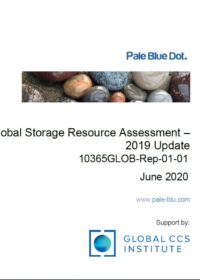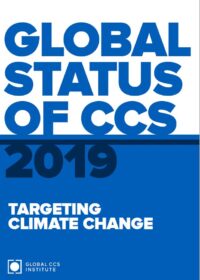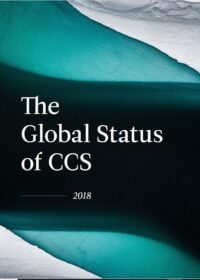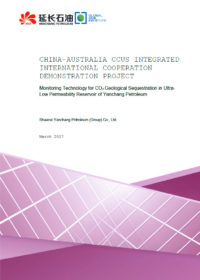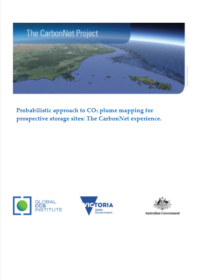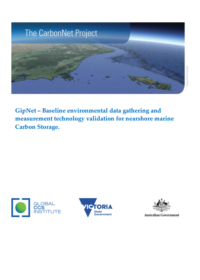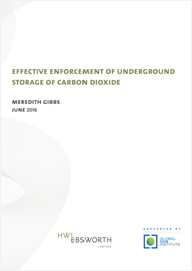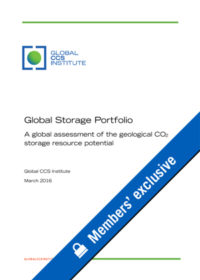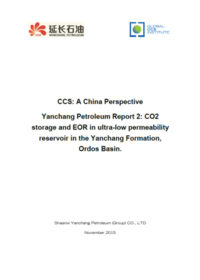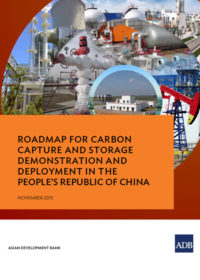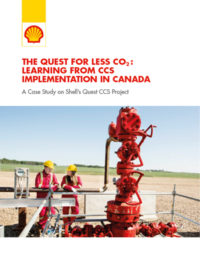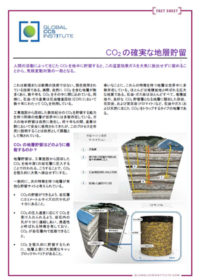Resources
Publications
Our publications, reports and research library hosts over 500 specialist reports and research papers on all topics associated with CCS.
View our Publication Library Disclaimer.
Filter by
Global Storage Resource Assessment 2020
2nd July 2020
Organisation(s): Global CCS Institute, Pale Blue Dot
Topic(s): CO2 storage
The CO2 Storage Resource Catalogue is a pioneering initiative to accelerate the deployment of carbon capture, utilization and storage (CCS) by supporting the consistent evaluation of storage resources.
This report, authored by Pale Blue Dot Energy, details the findings of the first assessment for CO2 Storage Resource Catalogue.
Disclaimer
The content within the Global CCS Institute Publications, Reports and Research Library is provided for information purposes only. We make every effort and take reasonable care to keep the content of this section up-to-date and error-free. However, we make no claim as to its accuracy, currency or reliability.
Content and material featured within this section of our website includes reports and research published by third parties. The content and material may include opinions and recommendations of third parties that do not reflect those held by the Global CCS Institute.
Global Status of CCS Report: 2019
9th December 2019
Topic(s): Carbon capture and storage (CCS), CO2 hubs, CO2 storage, CO2 transport, Policy law and regulation
The 2019 Global Status of CCS report documents important milestones for CCS over the past 12 months, its status across the world and the key opportunities and benefits the technology presents.
The report provides detailed information on, and analyses of, the global CCS facility pipeline, policy, CO2 storage and the legal and regulatory environment. In addition, four regional updates and a CCS Technology section further demonstrate global development and the versatility of CCS across a variety of applications and industry sectors.
Disclaimer
The content within the Global CCS Institute Publications, Reports and Research Library is provided for information purposes only. We make every effort and take reasonable care to keep the content of this section up-to-date and error-free. However, we make no claim as to its accuracy, currency or reliability.
Content and material featured within this section of our website includes reports and research published by third parties. The content and material may include opinions and recommendations of third parties that do not reflect those held by the Global CCS Institute.
Global Status of CCS Report: 2018
10th December 2018
Organisation(s): Global CCS Institute
Topic(s): Carbon capture and storage (CCS), CCS policy, CO2 hubs, CO2 storage, CO2 transport
The Global Status of CCS Report 2018 documents the status of CCS around the world and significant operational milestones over the past 12 months. It demystifies common misunderstandings about the technology and identifies where and how it can, and must, be more widely deployed. It also tracks the worldwide progress of CCS technologies and the key opportunities and challenges CCS faces.
Disclaimer
The content within the Global CCS Institute Publications, Reports and Research Library is provided for information purposes only. We make every effort and take reasonable care to keep the content of this section up-to-date and error-free. However, we make no claim as to its accuracy, currency or reliability.
Content and material featured within this section of our website includes reports and research published by third parties. The content and material may include opinions and recommendations of third parties that do not reflect those held by the Global CCS Institute.
Monitoring Technology for CO2 Geological Sequestration in Ultra-Low Permeability Reservoir of Yanchang Petroleum
29th March 2017
Topic(s): CO2 storage
To promote the development of CCS in China, the Global CCS Institute and China National Development and Reform Commission (NDRC) held a joint carbon capture, utilisation and storage (CCUS) workshop in Yan’An China in July 2013. Out of this collaboration the Global CCS Institute has commissioned Yanchang Petroleum Group to produce four knowledge-sharing reports on its integrated CCS project.
The third report of the series discusses the monitoring and verification technologies and techniques of Yanchang Petroleum CCUS Project. It highlights project achievements, lessons learned and the future monitoring workplan.
Disclaimer
The content within the Global CCS Institute Publications, Reports and Research Library is provided for information purposes only. We make every effort and take reasonable care to keep the content of this section up-to-date and error-free. However, we make no claim as to its accuracy, currency or reliability.
Content and material featured within this section of our website includes reports and research published by third parties. The content and material may include opinions and recommendations of third parties that do not reflect those held by the Global CCS Institute.
Probabilistic approach to CO2 plume mapping for prospective storage sites: The CarbonNet experience
30th November 2016
Topic(s): CO2 storage
The Global CCS Institute is supporting the development of the CarbonNet Project through a series of reports and enable the sharing of knowledge throughout its development. The CarbonNet Project is in its feasibility phase and planning the development of a hub-based network that will centre on a large capacity pipeline to deep, secure storage sites, offshore Victoria, Australia. The Project is planning to store up to 125 million tonnes over 25 years in the Gippsland Basin.
The Gippsland Basin holds world class geologic formations for CO2 storage with multiple 100-150m thick, multi-Darcy, clean quartz-dominated sands, overlain by thick caprocks. The ideal geologic conditions means that the CO2 will be mobile and enable accurate plume prediction modelling which is critical during this phase of CarbonNet's site characterisation. Moreover, in Australia storage regulations require plume path predictions with more than 10 per cent probability, that is 90% confidence of the CO2 plume's movement throughout the project’s lifecycle. Because of the petroleum industry’s decades of experience in modelling and probabilistic analysis, CarbonNet has been able to adapt this expertise for CO2 storage modelling in the Gippsland Basin.
The modelling focussed on a large anticlinal structure in the near shore Gippsland Basin, with an injection point down dip from the crest of the structure. The modelling and probabilistic analysis found that the variations in input data for porosity, permeability and residual gas saturation strongly affect the horizontal and lateral movement of the plume in the formations. The simulation modelling was completed over seven time frames from 10 years through to 300 years after injection commences. The analysis found that after the injection of 125 million tonnes, the CO2 plume migrated into the anticlinal structure but never moved outside the structure. CarbonNet's CO2 plume modelling methodology enables a quantified plume path uncertainty analysis both laterally (i.e. map view) and vertical extent (cross-section), offering 3D understanding of plume containment. This report confirms that containment can be demonstrated with an appropriate high level of regulatory and public confidence.
Disclaimer
The content within the Global CCS Institute Publications, Reports and Research Library is provided for information purposes only. We make every effort and take reasonable care to keep the content of this section up-to-date and error-free. However, we make no claim as to its accuracy, currency or reliability.
Content and material featured within this section of our website includes reports and research published by third parties. The content and material may include opinions and recommendations of third parties that do not reflect those held by the Global CCS Institute.
GipNet – Baseline environmental data gathering and measurement technology validation for nearshore marine Carbon Storage
22nd August 2016
Topic(s): CO2 storage, CO2 transport
Disclaimer
The content within the Global CCS Institute Publications, Reports and Research Library is provided for information purposes only. We make every effort and take reasonable care to keep the content of this section up-to-date and error-free. However, we make no claim as to its accuracy, currency or reliability.
Content and material featured within this section of our website includes reports and research published by third parties. The content and material may include opinions and recommendations of third parties that do not reflect those held by the Global CCS Institute.
Effective enforcement of underground storage of carbon dioxide
5th August 2016
Topic(s): CO2 storage, Policy law and regulation
The perception of an effective enforcement regime that ensures the secure and safe storage of CO2 in underground geologic formations will be crucial in increasing public and industry confidence in carbon capture and storage (CCS) as a viable low-carbon technology.
An effective enforcement regime for underground storage of CO2 has the following key features:
- Comprehensive obligations that address the key risks of underground storage of CO2
- Comprehensive monitoring and verification (M&V) requirements, including baseline monitoring, M&V obligations during the injection phase and M&V obligations post-injection
- Enforcement mechanisms that are risk-based, layered and flexible, grounded in science and fact-based decision-making, and include the ability to deal with 'serious situations' (such as unintended releases and CO2 not behaving as predicted)
- A clear allocation of roles and responsibilities for enforcement.
Disclaimer
The content within the Global CCS Institute Publications, Reports and Research Library is provided for information purposes only. We make every effort and take reasonable care to keep the content of this section up-to-date and error-free. However, we make no claim as to its accuracy, currency or reliability.
Content and material featured within this section of our website includes reports and research published by third parties. The content and material may include opinions and recommendations of third parties that do not reflect those held by the Global CCS Institute.
Global storage portfolio: a global assessment of the geological CO2 storage resource potential
1st March 2016
Topic(s): Carbon capture use and storage (CCUS), CO2 storage, Engineering and project delivery
The primary purpose of the Institute’s Global Storage Portfolio is to collate and summarise published regional assessments of key nations. The Portfolio also summarises key data on a nation’s readiness to host a commercial, large-scale project. For this reason, only proven storage scenarios including deep saline formations (DSF), depleted/depleting oil and gas fields (DGOF) and enhanced oil recovery using CO2 (CO2-EOR) are considered. The analysis has found that:
- Substantial storage resources are present in most key regions of the world.
- Reliable methodologies to determine and classify regional storage resources are available and have been widely applied, although there is no formally recognised international standard.
- The level of resource assessment undertaken and the availability of characterisation data is highly variable across regions.
- The level of detail a regional resource assessment has progressed as well as the policy, legal and regulatory frameworks are key criteria that can be used to gauge the readiness of any given nation to deploy a CCS project.
The storage resources are grouped into five regions:
- Asia-Pacific (fourteen countries)
- Americas (five countries)
- Middle East (three countries)
- Europe and Russia (EU plus three countries)
- Africa (four countries).
The resulting portfolio will enable the reader to rapidly establish a snapshot of a country’s storage resource and potential to deploy a large-scale project.
Disclaimer
The content within the Global CCS Institute Publications, Reports and Research Library is provided for information purposes only. We make every effort and take reasonable care to keep the content of this section up-to-date and error-free. However, we make no claim as to its accuracy, currency or reliability.
Content and material featured within this section of our website includes reports and research published by third parties. The content and material may include opinions and recommendations of third parties that do not reflect those held by the Global CCS Institute.
Yanchang Petroleum report 2: CO2 storage and EOR in ultra-low permeability reservoir in the Yanchang Formation, Ordos Basin
22nd January 2016
Topic(s): Carbon capture use and storage (CCUS), CO2 storage, CO2 utilisation
To promote the development of CCS in China, the Global CCS Institute and China National Development and Reform Commission (NDRC) held a joint carbon capture, utilisation and storage (CCUS) workshop in Yan’An China in July 2013. Out of this collaboration the Global CCS Institute has commissioned Yanchang Petroleum Group to produce four knowledge-sharing reports on its integrated CCS project.
This second report of the series discusses the storage aspects of Yanchang Petroleum CCUS Project. It highlights project achievements and lessons learned from the project.
Christopher Consoli, Institute Senior Adviser for Storage, Asia-Pacific provides an overview of this report in an Insight available on the Global CCS Institute website.
Disclaimer
The content within the Global CCS Institute Publications, Reports and Research Library is provided for information purposes only. We make every effort and take reasonable care to keep the content of this section up-to-date and error-free. However, we make no claim as to its accuracy, currency or reliability.
Content and material featured within this section of our website includes reports and research published by third parties. The content and material may include opinions and recommendations of third parties that do not reflect those held by the Global CCS Institute.
Roadmap for carbon capture and storage demonstration and deployment in the People’s Republic of China
2nd December 2015
Topic(s): Carbon capture use and storage (CCUS), CO2 capture, CO2 storage, CO2 utilisation, Domestic policy, Policy law and regulation
This Roadmap provides information on how China could achieve its climate goals through policy measures that encourage the deployment of CCS out to 2050. The work draws from economic modelling by experts at The Institute of Energy, Environment and Economy at Tsinghua University, and The International Institute for Applied Systems Analysis.
Additional Work Package Reports
- Road Map for Carbon Capture and Storage (CCS) Demonstration and Deployment: Work Package 1 Report - Review of CCS Roadmaps (March 2015)
- Road Map for Carbon Capture and Storage (CCS) Demonstration and Deployment: Work Package 4 Report - CCS Regulatory Framework for the People's Republic of China (March 2015)
- Road Map for Carbon Capture and Storage (CCS) Demonstration and Deployment: Work Package 5a Report and 5b Report - Opportunities for CCS Deployment in the People's Republic of China under Low Carbon Transformation Scenarios (Mar 2015)
- Road Map for Carbon Capture and Storage (CCS) Demonstration and Deployment: Component B - Oxy-Fuel Combustion Technology Assessment
Insights about this report, from Lawrence Irlam (Global CCS Institute Senior Adviser Policy & Economics), Tony Wood (the Grattan Institute’s Energy Program), and Annika Seiler (Finance Specialist (Energy) with the Asian Development Bank (ADB)) are available on the Global CCS Institute website.
Disclaimer
The content within the Global CCS Institute Publications, Reports and Research Library is provided for information purposes only. We make every effort and take reasonable care to keep the content of this section up-to-date and error-free. However, we make no claim as to its accuracy, currency or reliability.
Content and material featured within this section of our website includes reports and research published by third parties. The content and material may include opinions and recommendations of third parties that do not reflect those held by the Global CCS Institute.
The Quest for less CO2: learning from CCS implementation in Canada. A case study on Shell’s Quest CCS Project
18th November 2015
Topic(s): Carbon capture use and storage (CCUS), CO2 capture, CO2 storage
Shell presents this case study on the Quest Carbon Capture and Storage Project. By capturing and permanently storing CO2 from Shell’s oil sands operations, the Quest flagship project will reduce CO2 emissions by more than one million tonnes a year.
Disclaimer
The content within the Global CCS Institute Publications, Reports and Research Library is provided for information purposes only. We make every effort and take reasonable care to keep the content of this section up-to-date and error-free. However, we make no claim as to its accuracy, currency or reliability.
Content and material featured within this section of our website includes reports and research published by third parties. The content and material may include opinions and recommendations of third parties that do not reflect those held by the Global CCS Institute.
インスティテュートは、CCSに関する基本情報をまとめたFACT SHEETシリーズを作成した。「CO2の確実な地層貯留」は、CO2の貯留に焦点を当て概要をとりまとめたものである。
Japanese translation of Secure geologic storage of CO2.
Disclaimer
The content within the Global CCS Institute Publications, Reports and Research Library is provided for information purposes only. We make every effort and take reasonable care to keep the content of this section up-to-date and error-free. However, we make no claim as to its accuracy, currency or reliability.
Content and material featured within this section of our website includes reports and research published by third parties. The content and material may include opinions and recommendations of third parties that do not reflect those held by the Global CCS Institute.
